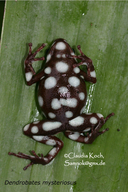|
Description
Adults 27-29 mm SVL. Dendrobates mysteriosus is the only Peruvian representative in the subfamily Dendrobatinae which is larger than ~22 mm SVL. Morphologically, this is one of the most distinctive poison frogs. Adults are black or brown with white ‘polka-dots’ covering the dorsal and ventral sides of the entire body and appendages. Although this spotting is highly variable, adults consistently have a single spot under the chin, and an ovoid spot on the underside of the thighs. Dorsal skin relatively granular. First finger slightly shorter than the second although well developed.
Tadpoles are black and elongate, with a labial tooth row formula of 2(2)/3(1).
Distribution and Habitat
Country distribution from AmphibiaWeb's database: Peru
This species is known only from the vicinity of the type locality, Santa Rosa, Cajamarca, Peru. This is a montane species endemic to the Cordillera del Condor, occurring 900-1100 m elevation. The area is exceptionally dry during several months of the year, and the remaining forests near Santa Rosa contain many species of succulents and cacti. The frogs are strict phytotelm-dwellers, and can be found living in enormous bromeliads growing on the sides of cliffs and rocky outcroppings. Life History, Abundance, Activity, and Special Behaviors
This species is tightly linked to water-holding bromeliads. Adults and juveniles are rarely found outside of bromeliads, except during wet periods, where they appear to move to the ground to forage on small insects. Males typically call from exposed positions on bromeliads. The advertisement call consists of a rattle-like buzz which is repeated several times per minute. Eggs are deposited in bromeliad bracts; the male then transports and deposits tadpoles in pools formed in the bromeliad.
These frogs can be highly abundant in areas where bromeliads are common. Trends and Threats
This species is severely threatened in the wild. The area around Santa Rosa has been almost entirely destroyed for coffee farms and very few patches of intact forest exist. Frogs are now restricted to 5 or 6 known localities around Santa Rosa, each of which is very small (< 1-2 hectares) and surrounded by deforested land. Additionally, several of these localities are situated on the faces of cliffs and could easily be destroyed by natural or anthropogenic disturbances. Fortunately, land around two of these cliffs has been purchased by the IUCN and is currently protected by a committee of local farmers. This species has also been very hard hit by smugglers, particularly in the late 90s and early 00s. Smuggling operations still continue around Santa Rosa, despite the fact that this species is now readily available on the European black market. Relation to Humans
Highly desired as a terrarium pet. Possible reasons for amphibian decline General habitat alteration and loss
Intentional mortality (over-harvesting, pet trade or collecting)
Comments
This species was rediscovered in 1989, 60 years after its original collection (Schulte 1990). Myers (1982) suggested this species was a close relative of D. captivus on the basis of hand morphology and a pale, ovoid spot under the thigh. Schulte (1990) vehemently opposed this hypothesis, suggesting that D. mysteriosus was more closely related to members of Oophaga on the basis of size and call parameters, although he did not provide any useful call characteristics aside from dominant frequency. Twomey and Brown (2008) provided the first phylogenetic analysis containing both D. captivus and D. mysteriosus, and found support for Myers’ hypothesis that these two species were close relatives. Because of the genetic and morphological dissimilarities between these species and all other species of Ranitomeya, Twomey and Brown (2008) proposed a new genus, Dendrobates, to include these species.
References
Myers, C.W. (1982). ''Spotted poison frogs: Descriptions of three new Dendrobates from western Amazonia, and resurrection of a lost species from ''Chiriqui''.'' American Museum Novitates, 2721, 1-23.
Schulte, R. (1990). ''Redescubrimiento y redefinicion de Dendrobates mysteriosus (Myers 1982) de la Cordillera del Condor.'' Boletin de Lima, 70, 57-68.
Twomey, E. and Brown, J. L. (2008). ''Spotted poison frogs: rediscovery of a lost species and a new genus (Anura: Dendrobatidae) from northwestern Peru.'' Herpetologica, 64, 121-137.
Originally submitted by: Evan Twomey (first posted 2008-05-20)
Edited by: Kellie Whittaker (2010-09-22)Species Account Citation: AmphibiaWeb 2010 Excidobates mysteriosus: Marañón Poison Frog <https://amphibiaweb.org/species/1639> University of California, Berkeley, CA, USA. Accessed Jul 26, 2024.
Feedback or comments about this page.
Citation: AmphibiaWeb. 2024. <https://amphibiaweb.org> University of California, Berkeley, CA, USA. Accessed 26 Jul 2024.
AmphibiaWeb's policy on data use.
|
